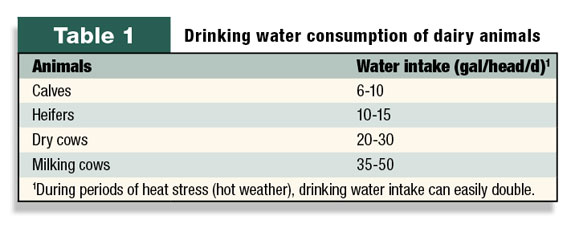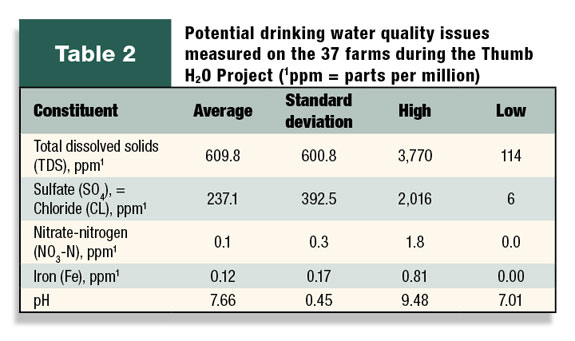Dairy producers spend a great deal of time, effort and money ensuring dairy cow rations are fine-tuned to the “nth” degree. A few milligrams of this, a few parts per million of that, all to ensure no stone goes unturned in the quest for the perfect ration. Unfortunately, in the process the most important nutrient of all often goes barely noticed and only lightly considered. What nutrient? Water.

Recall that water weighs 8.35 lbs/gal. Even though we normally don’t think in such terms, water, by weight, is the largest component of the daily ration for all classes of dairy animals. (See Table 1.)
This is particularly true of the milking cow. If you consider her total ration, it will contain somewhere around 50 to 60 lbs of dry matter (DM) per day in the form of what we normally think of as “ration” (carbohydrates, proteins, fats, vitamins and minerals).
But just as importantly or even more, the ration also consists of about 42 gallons of drinking water. When you convert the total water consumption to weight, the milking cow is consuming around 420 lbs of water per day (42 gal. drinking water X 8.35 lbs/gal + 120 lbs as-fed ration X 55 percent water = 350.7 lbs drinking water + 66.0 lbs water from feed = 416.7 lbs total water intake per day).
That means the dry matter intake we usually focus on accounts for only about 12 percent of the cow’s total nutrient intake, while water accounts for about 88 percent. In fact, the water requirement of a lactating dairy cow on a per-pound-of-bodyweight basis is the highest of any land-based mammal.
How much attention does drinking water receive on your farm?
Drinking water should receive your attention in two regards: water quality (Is your water fit to drink based on its chemical and mineral composition?) and water delivery (Are you providing an ample supply of good quality, fresh, clean water to your cattle?).
According to Michigan State University’s Dr. David Beede, the most important constituents to evaluate in regards to water quality are: total dissolved solids (TDS), sulfate (SO4), chloride, (Cl), iron (Fe) and nitrate-nitrogen (NO3-N).
Total dissolved solids measures the sum of all inorganic matter dissolved in water, and is an indicator of the salinity of water. Experts usually recommend that TDS levels above 1,000 ppm should be investigated further and potentially be corrected to prevent and/or correct problems like diarrhea and dehydration.
If the combined sulfate + chloride content of dairy cattle drinking water is greater than 500 ppm, further testing and evaluation are needed. At higher-than-recommended levels, these minerals may lead to health and production problems.
For example, some have observed that high levels of sulfate + chloride cause diarrhea and dehydration in calves, plus increased retained placentas and displaced abomasums in fresh cows.
Nitrate-nitrogen levels in cattle drinking water should not exceed 20 ppm. High nitrate-nitrogen levels have been associated with long-term reproductive problems in dairy cows, such as higher services per conception, lower first-service conception rates, and longer calving intervals.
If dairy cattle drinking water contains over 0.3 ppm iron, cows may suffer from iron toxicity. Iron in drinking water is in the ferrous state (Fe2+) and is soluble, odorless and easily absorbed in the animal’s gut. However, most dairy rations provide more-than-adequate iron which is in the less-absorbable ferric state (Fe3+).
This form of iron is converted in the animal’s gut to ferrous iron (Fe2+) and absorbed for use by the animal’s tissues. When drinking water contains excess ferrous iron (Fe2+), this may lead to excess ferric iron (Fe2+) in the animal’s tissues, causing “oxidative stress” where cell membranes lose integrity.
This can lead to increased retained placentas, mastitis, metritis and a general compromising of the animal’s immune system. Problems related to depressed immune function are more likely to show up in transition and fresh cows, reducing peak milk yield.
High iron in drinking water also may depress water intake due to palatability issues, although this is not well understood. Excess soluble iron (Fe2+) in the animal’s gut also reduces absorption of other key minerals like zinc and copper.
In addition to the problems these various water constituents may cause to cattle health and performance, they also may contribute to problems with your farm’s water delivery system (e.g., pumps and pipes) and the effectiveness of pipeline cleaning and sanitizing.
This could in turn lead to increased bacteria counts and buildup within water pipes, restricting water flow. For example, high iron levels in water encourage the growth of iron bacteria that plug pipes and coat pumps and other water system components with a slick, rust-colored slime.
How should you address water quality issues?
First, you should test your cattle’s drinking water on a quarterly basis for TDS, sulfate, chloride, iron and nitrate-nitrogen. Second, you should check to make sure your dairy facility’s water delivery system meets guidelines for number of waterers, space, location and cleanliness.
A one-page fact sheet (Three Common Drinking Water Problems on Dairy Farms) providing clues on these issues, along with guidelines for taking water samples for analysis and potential certified laboratories that analyze water samples, is available by e-mailing your request to thomasc@msu.edu.
Thumb H2O Project
To examine these important water issues even further, I conducted a project called the Thumb H2O Project. This project involved 37 dairy farms in Huron, Sanilac, St. Clair and Tuscola counties in Michigan.
Milking cow drinking water was sampled on each farm and then analyzed using the services of a certified commercial laboratory. The water analysis test used is called the “Livestock Suitability Test” and included sodium (Na), calcium (Ca), magnesium (Mg), pH, nitrate-nitrogen (NO3-N), sulfate (SO4), conductivity, total dissolved solids (TDS), iron (Fe), chloride (Cl) and copper (Cu).
In addition, data were collected on these farms from their milking parlors and milking cow housing facilities concerning number of waterers, space, location and cleanliness.

Water quality issues were found on 27 percent of the farms sampled. Table 2 breaks down these potential water quality issues into five categories.
High total dissolved solids were found on 13.5 percent of farms, with TDS levels as high as 3,770 ppm.
Sulfate + chloride problems were found on 8.1 percent of farms, with sulfate + chloride levels as high as 2,016 ppm. High iron was found on 10.8 percent of farms, with levels as high as 0.81 ppm.
None of the farms’ water samples showed elevated levels of nitrate-nitrogen. The highest nitrate-nitrogen level found was only 1.8 ppm. One farm had a high pH (9.48).
This was included as a potential water quality problem because EPA water quality guidelines for human consumption suggest that a pH of greater than 8.5 can result in water that has a bitter taste, that is corrosive to pipes and in which the germicidal effectiveness of chlorine is reduced. The effect of drinking water pH on animal performance and health has not been well researched.
These data clearly indicated that potential water quality issues do exist on nearly one-quarter of the farms tested. Every dairy participating in the study was encouraged to perform follow-up water analyses to confirm/deny that the potential water quality issues detected are real and whether water treatment strategies should be sought to correct these problems.
MSU Extension encourages all dairy farmers to implement a routine water testing program on their operation and track these analyses over time. Water quality is not something that remains constant, but rather changes as the underlying aquifer changes.
Also, some farms on this study sourced cow drinking water from more than one well. Thus, be sure all sources of drinking water for your operation are included in your testing program. PD
References omitted due to space but are available upon request to editor@progressivedairy.com.
—Excerpts from Michigan Dairy Review, Vol. 16, No. 1, pgs. 16, 17 and 23
Craig Thomas is an extension dairy educator withMichigan State University Extension. Email Craig Thomas.





